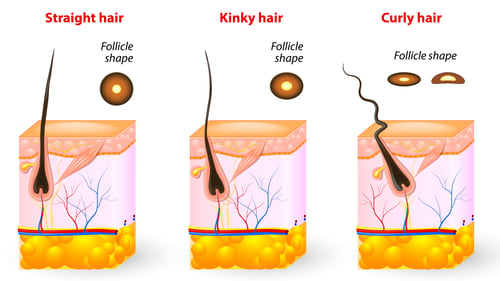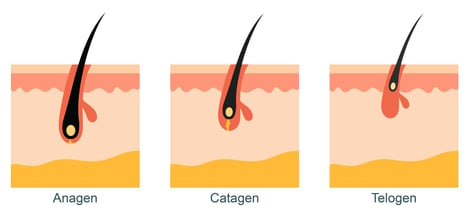On this page
- Why is the science of hair so relevant?
- So, what do we need to know?
- To Curl or Not to Curl
- The rainbow of hair colors
- Key takeaways
- Sources and further readings
We believe that each individual is beautiful in their own way and, that this in turn, should be reflected in the personal care products on the market. In particular, hair provides people with a sense of identity; its styling is something that is important and symbolic across genders and cultures. Don’t you remember that time you got a bad haircut and didn’t feel comfortable for months? Of course, you do, it’s happened to everyone. The point is, hair is important to everyone and to address this, one must understand the science behind different hair types.
Why is the science of hair so relevant?
- We’ll start by stating the obvious. Understanding the science means that you can provide the right products, that in turn can be incorporated into well-functioning, effective and safe personal care hair products.
- The need to personalize products for the end consumer: shop for any foundation online and you will find that you are required to fill out a questionnaire about your own skin in order to then be assigned the right foundation (try the Maybelline foundation match finder here). End consumers of cosmetic products are looking for personalization which means the need to understand differences on a technical level is crucial.
Having acknowledged this, and identified it as a need, Covalo is addressing the science behind hair types, hair products and how to cater to them in this blog feature. As you may already know, Covalo is a search engine of personal care ingredients, which to date comprises more than 20,000 products. Don’t miss out on the hair care product ingredients that are already out there and that actually already target a specific type of hair. Our ingredient database is one of the more comprehensive ones available and will simplify your search. Try it out today here: Covalo.com.
So, what do we need to know?
The term hair type broadly refers to the texture and to the color of hair, but also to the growth cycle and age of hair. On a technical level, hair type is influenced by
- the shape of the hair shaft
- the structure of the hair fiber
- the growth of hair follicles and
- the pigmentation that ensues.
If at this stage understanding the many variables affecting the type of hair sounds like a tough nut to crack, don’t worry, we’re going to break it down for you.
To Curl or Not to Curl
The texture of hair is the result of the extent to which hair does (or does not) curl, which in turn can be explained by the structure of hair. Each strand of hair is made up of two key components: the follicle and the shaft. The follicle is the part of the hair located under the skin: the root (as shown in the picture below). The shaft, as we’re sure you’ve guessed, is the other part, located externally (also pictured in the image below). Both of their shapes and their structures are genetically determined; in turn affecting the resulting hair structure.

Let’s start at the root of the question then: what does the follicle do? The shape of the follicle’s face may either be oval or round. A circular follicle results in straight hair and conversely, a more oval follicle results in a curl. The extent to which hair curls is thereby determined by how oval the follicle is. The shape of the follicle also affects the way in which the hair turns into the skin. An oval follicle turns into the skin (or dermis) at a curved angle, resulting in hair growing out in a curl. In contract, a circular follicle lies directly perpendicular to the skin: it does not curve into the skin, thereby resulting in straight hair.
The hair shaft also contributes to the texture. The entirety of a strand of hair is made up of keratin, a protein consisting of 18 amino acids, one of which is cysteine. Cysteine contains amounts of sulfur. Sulfur, a group 6 atomic element, is capable of forming 2 bonds, in particular, in a linkage bond known as a disulfide bridge. Why is this relevant? Well, the point here is that these ‘bridges’ are responsible for the way your hair strands link together, and the resultant structure of your hair. From a personal care perspective, understanding hair styling and care comes from understanding how to control disulfide bridging; but that is a story (or blogpost) for another day.
The rainbow of hair colors
We've already said that hair type is more than hair texture, but also hair color. So, what is responsible for your hair color? We assume you know that pigmentation plays a role in there somewhere, but how? Well, in short, human hair color is determined by two key pigments: eumelanin and pheomelanin. Eumelanin can be either brown or black, whilst pheomelanin is either red or yellow. The ratios of these different pigments to each other, and their respective coloring (genetically determined) is responsible for the hair color that one ends up seeing. Variation in hair color is endless: not only do genetics play a role in it, but so does age. With age, comes a reduction in pigmentation, thereby explaining why hair turns grey and/or white.
The question of timing also begins to come into play when considering the hair growth cycle. In short, this takes place in 3 phases:
- Anagen: the active growth stage of the hair fiber, lasting anywhere between 2 and 7 years
- Catagen: the bridging phase during which hair growth slows down and eventually halts
- Telogen: occurring after the hair falls out and is completely at rest
The formation of the hair, occurring beforehand is when pigmentation occurs.

Sounds like a mouthful, but the key message is that if you can understand the cycle and, the stages at which pigmentation takes place, this opens the door to a range of products customized to this.
From this post, what we guess you’ve realized by now is that hair isn’t simple. There are so many variables involved, and genetics come into play in that they offer a wide spectrum of potential hair textures, colors and more. The possibilities with respect to hair are countless, and this article here is barely the tip of the iceberg… or the root of the topic. That’s why we’re now doing a hair care feature to shed light on the issue.
Keep an eye on our blog for more information and start searching for different hair care ingredients on Covalo.
Key takeaways:
- Hair differs from one person to another (just look at the people around you whilst you read this!), the main factors to consider: the shape, the pigmentation and the resulting structure.
- The hair growth cycle and age are also two important variables to keep in mind and that change over time.
- The consumer industry is demanding personalization of cosmetic products, so to be ahead of the curve and provide for this, it’s important to acknowledge different hair types from a scientific perspective.
Sources and further readings:
For understanding hair structure: A guide trough different hair type by www.curls.biz
For understanding hair color: An article by Rachel Nall for Livestrong.com
For understanding the hair growth cycle: An article from the CRIA hair blog
Covalo is the most comprehensive personal care ingredient platform, making your search for the right ingredient super simple and speedy. You're only a few clicks away from finding just what you need.
Disclaimer: The information provided (on our blog) is accurate to the best of our knowledge, however, there may be errors. As a neutral organization, we at Covalo do not advocate or promote certain products or ingredients on our platform as better than others. The Site may contain (or you may be sent through the Site) links to other websites or content belonging to or originating from third parties or links to websites and features in banners or other advertising. Such external links are not investigated, monitored, or checked for accuracy, adequacy, validity, reliability, availability or completeness by us. For more information on our blog, contact social@covalo.com



